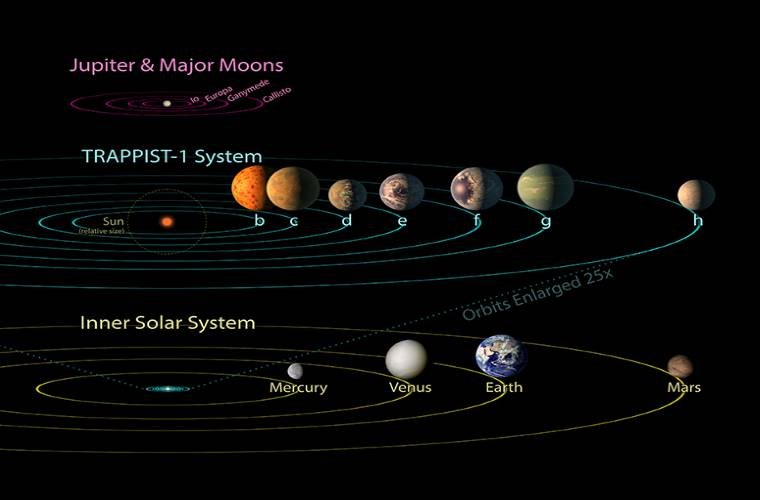A new study claims solar flares may actually make the planets in Trappist-1’s habitability zone even more habitable than first thought.
Located about 40.7 light years from our own solar system, the Trappist-1 planetary system has excited astronomers and astrobiologists alike due to the large number of rocky, Earth-like planets in the system that may also reside within the star’s habitability zone where liquid water can exist on the surface. Water is a key ingredient to life on Earth, making it a significant factor for astrobiologists hunting for life outside Earth.
Solar Flares May Aid Habitability, not Hinder it
According to the new study published in the journal Astronomy and Astrophysics, Trappist-1 periodically emits massive solar flares that blast the planets within the system with high-energy particles and solar radiation. Many researchers have suggested that the intense types of solar flares that are common to red dwarf stars may eventually strip away an exoplanet’s atmosphere, leaving it ill-equipped to sustain life as we know it.
However, the authors of this study suggest that these flares may actually aid the habitability of the planets within the Trappist-1 system by offering the planets more energy to fuel the pre-biotic soup of amino acids, peptides, and other chemicals most believe to be the precursors to the first, most primitive forms of life that first formed on Earth over 3 billion years ago.
“Although high energetic radiation from flares is a potential threat to exoplanet atmospheres and may lead to surface sterilization,” the study’s authors write, “it might also provide the extra energy for low-mass stars needed to trigger and sustain prebiotic chemistry.”
Critics of the new study note that it is a pre-print report, meaning it has yet to be peer-reviewed. Those same critics also point out that a lot more factors besides solar radiation may affect an exoplanet’s habitability and that a more holistic approach should be taken to determine if there is actually anything alive on any of the planets orbiting Trappist-1.
“A more complete approach (but harder to explain) is to just find out all you can about the atmospheres of exoplanets (molecular composition, temperature, etc.), then try to create models to explain the observations by considering geology, physics, and chemistry (e.g., volcanoes, meteorites, photochemistry, etc.),” explained University of New South Wales quantum chemist and molecular physicist Laura McKemmish in a piece for Newsweek. “If it can’t be explained, then you can start to consider biology. (Biology in astrochemistry is often considered the hypothesis of last resort).”
James Webb Space Telescope May Answer Question of Trappist-1 Habitability
NASA’s recently launched James Webb Space Telescope is designed to take on a number of astronomical tasks. However, as public interest in the concept of life on other planets has increased, the telescope is increasingly expected to spend a significant amount of its precious time scanning the atmospheres of habitable zone exoplanets for biosignatures. Although not definitive signs of life, biosignatures are typically described as gases produced and used by living organisms, such as methane, oxygen, and carbon, found in concentration levels indicating a biological process behind their creation.
“There are possibly three planets in the TRAPPIST-1 system that may have conditions for habitability that will be observed by Webb,” NASA’s Dr. Knicole Colon, Deputy Project Scientist for Exoplanet Science on the James Webb Space Telescope team, told The Debrief last year. “Webb will look for water vapor and other molecules in the atmospheres of those planets,” hoping to determine that level of habitability.”
Of course, the researchers who will actually study Trappist-1’s exoplanets for signs of life note that even if they find a biosignature that would definitely indicate life on Earth, that may not be the case on these planets.
“Our expectations for what a habitable or even inhabited planet might look like when viewed from a great distance are largely built on what we’ve learned in [our] solar system,” Dr. Nikole Lewis, an astronomer at Cornell University, who is part of a team studying TRAPPIST-1e explained to The Debrief. “The TRAPPIST-1 system is very different from our Solar System, from the cool red star at its center to the seven earth-size planets in tight orbits about that star.”
Still, if the new study is correct and the solar flares produced by the host star are helping these planets cook up the ingredients for life, the team’s using the James Webb Telescope will likely find some tantalizing evidence soon.
“A successful detection would further reveal the bulk composition of the atmosphere, which is important information to assess the potential for life, as well as to understand the [evolutionary] history of the planet,” explained Dr. David Lafrenière of the University of Montreal, one of the researchers granted time on James Webb to study Trappist-1’s exoplanets, in an email to The Debrief,
In that same email, Dr. Lafrenière also conceded just how groundbreaking the results of his efforts and those of the other three teams studying this exoplanet system may be.
“Our study could achieve the very first detection of the atmosphere of an Earth-like planet in the habitable zone,” he told The Debrief,” which in itself would be a key step in the study of life elsewhere.”
Follow and Connect with Author Christopher Plain on Twitter @plain_fiction

